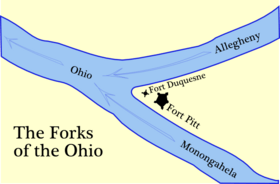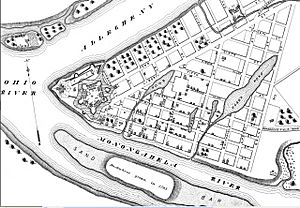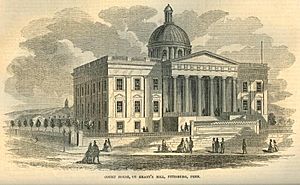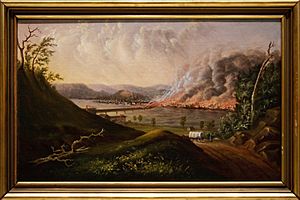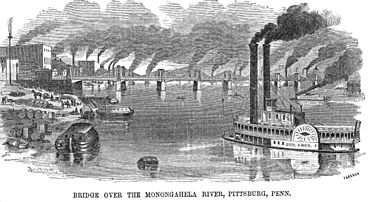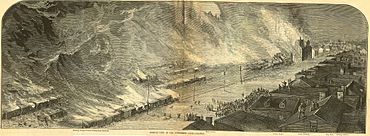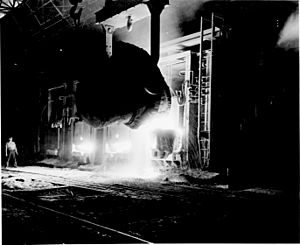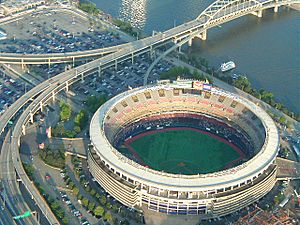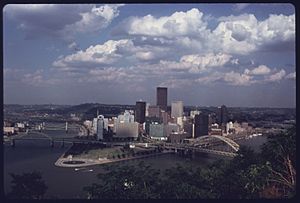History of Pittsburgh facts for kids
The history of Pittsburgh is a long and exciting story, starting with Native American tribes who lived there for thousands of years. They called the area "Dionde:gâ'" in the Seneca language. Later, European explorers discovered the special spot where the Allegheny and Monongahela rivers meet to form the Ohio River, which then flows to the Mississippi River. This location was very important, and soon, France and Great Britain fought over it in the 1750s during the French and Indian War. The British won, and France gave up its lands east of the Mississippi River.
After the American Revolutionary War ended in 1783, the small village around Fort Pitt began to grow. Farmers in the area even rebelled against federal taxes on whiskey in what was called the Whiskey Rebellion. The War of 1812 helped American factories grow because British goods were harder to get. By 1815, Pittsburgh was making lots of iron, brass, tin, and glass. By the 1840s, it was one of the biggest cities west of the Allegheny Mountains.
Steel production started in 1875. In 1877, workers protested wage cuts during the Great Railroad Strike of 1877, leading to the Pittsburgh Railway Riots. Buildings were burned, including 100 train engines and over 1,000 cars. Forty people died, mostly striking workers. By 1911, Pittsburgh was making half of all the steel in the United States!
Pittsburgh was a Republican city until 1932. But during the Great Depression, many people lost their jobs. New government programs and strong labor unions made the city turn towards the Democratic party. In World War II, Pittsburgh became a key part of the "Arsenal of Democracy", producing weapons and supplies for the Allied forces, which brought back jobs and prosperity.
After World War II, Pittsburgh started a big project called the "Renaissance" to clean up the air and rebuild parts of the city. Industries kept growing until the 1970s. Then, competition from other countries caused the steel industry to shrink, leading to many job losses and factory closures. Today, Pittsburgh has changed from a steel city to a center for medicine, education, and technology.
Contents
- Native American Life in Pittsburgh
- Early European Settlement (1747–1763)
- Becoming the Gateway to the West (1763–1799)
- The Iron City Era (1800–1859)
- The Steel City Era (1859–1946)
- Pittsburgh in the Early 20th Century
- The First Renaissance (1946–1973)
- Reinvention and Modern Pittsburgh (1973–present)
- Jurisdiction Timeline
- Images for kids
- See also
Native American Life in Pittsburgh
For thousands of years, Native Americans lived where the Allegheny and Monongahela rivers meet to form the Ohio River. Very early people, called Paleo-Indians, lived as hunter-gatherers here as far back as 19,000 years ago. Evidence of these first Americans has been found at Meadowcroft Rockshelter, an ancient site west of Pittsburgh.
Later, people from the Adena culture, known as Mound builders, built a large burial mound near what is now McKees Rocks, Pennsylvania. This mound was later added to by the Hopewell culture.
By the 1700s, the Iroquois Confederacy, a powerful group of five nations from New York, controlled the upper Ohio Valley, using it mainly for hunting. Other tribes, like the Lenape (also called Delaware) and the Shawnee, also lived in the area. When Europeans arrived, many Native Americans became sick from diseases like smallpox and measles, which they had never encountered before and had no protection against.
In 1748, a visitor named Conrad Weiser met with many warriors from different tribes at a place called Logstown, downriver from Pittsburgh. Some of the tribes present included the Seneca, Mohawk, Lenape, and Shawnee.
Several Native American villages were located near present-day Pittsburgh. Shannopin's Town, a Seneca village, was on the east bank of the Allegheny River. Sawcunk, a Lenape village, was at the mouth of the Beaver River. Chartier's Town was a Shawnee village, and Kittanning was a large village for both Lenape and Shawnee people.
Early European Settlement (1747–1763)
European traders first came to the Pittsburgh region in the 1710s. In 1717, a trader named Michael Bezallion described the forks of the Ohio River. Soon after, European trading posts were set up in the area.
In 1748, the first Ohio Company, an English group that bought and sold land, received a large grant of land in the upper Ohio Valley. They started building a wagon road from Maryland towards the Monongahela River. This road mostly followed an old Native American trail called Nemacolin's Path.
The French also wanted to control the Ohio Valley. In 1749, a French officer named Celeron de Bienville traveled down the Allegheny and Ohio rivers, placing markers to claim the land for France. He warned English traders to leave.
In 1753, the Governor of New France, Marquis Duquesne, sent a larger French expedition. They built Fort Presque Isle near present-day Erie and Fort Le Boeuf on French Creek. The next year, they built Fort Machault.
Virginia's Governor Dinwiddie was worried about the French. He sent Major George Washington to tell the French to leave. Washington arrived at the Forks of the Ohio on November 25, 1753. He then went to the French forts, but the French officers politely refused to leave.
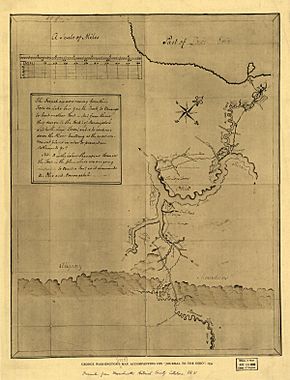
Governor Dinwiddie then sent Captain William Trent to build a fort at the Forks of the Ohio. On February 17, 1754, construction began on Fort Prince George. But in April 1754, over 500 French soldiers arrived. They forced the 40 British colonists to leave, tore down the unfinished fort, and built their own, stronger fort called Fort Duquesne.
Governor Dinwiddie sent another expedition led by Colonel Joshua Fry and his second-in-command, George Washington. On May 28, 1754, Washington's group fought with the French in the Battle of Jumonville Glen. Thirteen French soldiers were killed, and 21 were captured. After this, Washington's Native American ally, Seneca chief Tanacharison, killed the French commander. The French then chased Washington, and on July 3, 1754, George Washington had to surrender after the Battle of Fort Necessity. These events helped start the French and Indian War (1754–1763), a big conflict between England and France.
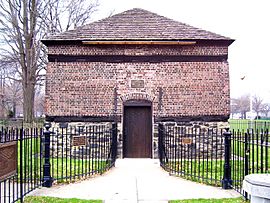
In 1755, George Washington joined British General Braddock's expedition. Over 3,000 men marched from Maryland, building a wagon road across the Allegheny Mountains. This road, known as Braddock's Road, was the first to cross the Appalachian Mountains. On July 9, 1755, French troops from Fort Duquesne ambushed Braddock's expedition at Braddock's Field. In the Battle of the Monongahela, the British suffered heavy losses, and General Braddock was badly wounded. The British forces had to retreat. This left the French and their Native American allies in control of the upper Ohio Valley.
In 1758, British General John Forbes began a new campaign to capture Fort Duquesne. With 7,000 troops, Forbes built Fort Ligonier and Fort Bedford and cut another wagon road over the Allegheny Mountains, called Forbes' Road. On November 25, 1758, the French, realizing they were outnumbered, burned and abandoned Fort Duquesne. Forbes occupied the burned fort and ordered the building of Fort Pitt, named after British Secretary of State William Pitt the Elder. He also named the settlement "Pittsborough." The British made Fort Pitt much stronger. The French never attacked it again, and the war ended with the Treaty of Paris, where France gave up its lands east of the Mississippi River.
Becoming the Gateway to the West (1763–1799)
In 1760, the first European settlement around Fort Pitt began to grow. Traders and settlers built homes near the fort and along the Monongahela River. By April 1761, a count showed 332 people and 104 houses.
In 1763, Native American tribes, led by Pontiac, tried to push the British out of the lands west of the Appalachians. They attacked many British forts, including Fort Pitt. Captain Simeon Ecuyer, who was in charge of the fort, prepared for a siege. He brought all the settlers inside the fort, including 330 men, 104 women, and 196 children. Pontiac's forces attacked on June 22, 1763. The siege of Fort Pitt lasted for two months. The Native Americans eventually left to fight Colonel Bouquet, who defeated them in the Battle of Bushy Run. This victory secured British control over the forks of the Ohio. In 1764, Colonel Bouquet added a small fort, called the Fort Pitt Blockhouse, which is still standing today and is the oldest building in Pittsburgh.
In 1768, the Iroquois signed a treaty, giving the lands south of the Ohio River to the British. More European settlers moved into western Pennsylvania. Between 1768 and 1770, about 4,000 to 5,000 families settled there. These settlers worked very hard, clearing forests, building homes, and making almost everything by hand. They also faced harsh winters and wild animals. Because of the fear of Native American raids, settlers often built their cabins near springs and built blockhouses for protection.
Conflicts with Native Americans continued, especially with the Shawnee, Miami, and Wyandot tribes, leading to Lord Dunmore's War in 1774. During the American Revolution, some Native Americans hoped the war would force the settlers to leave their lands. In 1777, Fort Pitt became a United States fort.
In 1780, Virginia and Pennsylvania agreed on their borders, making Pittsburgh part of Pennsylvania. The Revolutionary War ended in 1783, bringing a temporary peace to the border. In 1784, the Iroquois gave more land to Pennsylvania.
After the Revolution, Pittsburgh continued to grow. One of its first big industries was boat building. They built flatboats to carry pioneers and goods downriver and keelboats that could travel upriver. By the 19th century, Pittsburgh was even building ocean-going ships!
Important institutions began to develop. In 1787, the Pittsburgh Academy was founded, which later became the University of Pittsburgh.
Many farmers in the region made whiskey from their corn because it was easier to transport and was even used as money. When the government put a tax on whiskey, the farmers in Western Pennsylvania felt it was unfair. This led to the Whiskey Rebellion in 1794. Farmers marched on Pittsburgh, but President George Washington sent in militias, and the rebellion quickly ended.
By 1794, the town had its first courthouse. In 1797, glass manufacturing began.
| Year | City Population |
|---|---|
| 1761 | 332 |
| 1796 | 1,395 |
| 1800 | 1,565 |
The Iron City Era (1800–1859)
While trade was still important, manufacturing became more and more vital to Pittsburgh's economy. The city was in the middle of rich coalfields and had access to petroleum, natural gas, lumber, and farm goods. Blacksmiths made iron tools and parts. By 1800, Pittsburgh had a population of 1,565 people and over 60 shops.
The 1810s were a key time for Pittsburgh's growth. In 1811, the first steamboat was built in Pittsburgh, allowing goods to travel up and down the rivers more easily. The War of 1812 helped Pittsburgh's factories because it cut off the supply of goods from Britain. This encouraged American manufacturing. By 1815, Pittsburgh was producing a lot of iron, brass, tin, and glass products. When Pittsburgh officially became a city on March 18, 1816, it was already known for its trade, factories, and the constant cloud of coal dust from its industries.
Other towns tried to compete with Pittsburgh. In 1818, the first part of the National Road was finished, connecting Baltimore to Wheeling, West Virginia, and bypassing Pittsburgh. However, many improvements were made to Pittsburgh's transportation. In 1818, the first bridge over a river in the region, the Smithfield Street Bridge, opened. This was the start of Pittsburgh becoming the "City of bridges." In 1840, the Pennsylvania Turnpike connected Pittsburgh to Philadelphia. In 1834, the Pennsylvania Main Line Canal was completed, making Pittsburgh part of a big transportation system of rivers, roads, and canals.
Manufacturing continued to grow. In 1835, the first locomotive west of the Alleghenies was built in Pittsburgh. By the 1840s, Pittsburgh was one of the largest cities west of the mountains. In 1841, the Second Court House was finished, a beautiful building made of gray sandstone.
Like many growing cities, Pittsburgh's services, like its water supply, couldn't keep up. Because of this, on April 10, 1845, a huge fire destroyed over a thousand buildings and caused millions of dollars in damage. As the city rebuilt, the age of railroads arrived. In 1851, the Ohio and Pennsylvania Railroad started service between Cleveland and Allegheny City (now the North Side). In 1854, the Pennsylvania Railroad began service between Pittsburgh and Philadelphia.
Despite these challenges, Pittsburgh became a powerful industrial center. In 1857, a report showed that Pittsburgh and Allegheny City had:
- 939 factories
- Over 10,000 workers
- Produced almost $12 million in goods
- Used 400 steam engines
- Consumed 22 million bushels of coal
- Consumed 127,000 tons of iron
- Was the third busiest port in the nation for steamship traffic, after New York City and New Orleans.
| Year | City Population | City Rank |
|---|---|---|
| 1800 | 1,565 | NA |
| 1810 | 4,768 | 31 |
| 1820 | 7,248 | 23 |
| 1830 | 12,568 | 17 |
| 1840 | 21,115 | 17 |
| 1850 | 46,601 | 13 |
| 1860 | 49,221 | 17 |
The Steel City Era (1859–1946)
The iron and steel industry grew very quickly after 1830. It became a major part of American industry by the 1860s.
New Technologies and Leaders
In 1859, the Clinton and Soho iron furnaces started using coke for smelting iron. The American Civil War greatly boosted Pittsburgh's economy, as the city produced more iron and weapons. Factories like the Allegheny Arsenal and the Fort Pitt Foundry made iron-clad warships and large guns. By the end of the war, Pittsburgh was producing over half of the nation's steel and more than a third of its glass. A big step in steel production happened in 1875 when the Edgar Thomson Steel Works in Braddock began making steel rails using the new Bessemer process.
Important business leaders like Andrew Carnegie, Henry Clay Frick, Andrew W. Mellon, and Charles M. Schwab made their fortunes in Pittsburgh. George Westinghouse also started many companies in Pittsburgh, including Westinghouse Electric Company. He invented things like the air brake for trains. Banks, like T. Mellon & Sons Bank, helped finance these growing industries, for example, helping to create Alcoa, an aluminum company.
Growth of Industries and Towns
Starting in the 1870s, businesses changed the economy from small factories in the city to a large industrial area stretching 50 miles across Allegheny County. This new industrial Pittsburgh had large mills, mass production, and modern ways of managing businesses. Many companies looked for big areas with access to railroads and rivers. They bought land, built modern factories, and sometimes even built towns for their workers. This led to many new industrial suburbs and towns around Pittsburgh.
One example of a new industrial town was Vandergrift. In 1895, steelmaker George McMurtry hired famous landscape architect Frederick Law Olmsted to design Vandergrift as a model town. McMurtry believed that a good living environment would make workers happier and more productive. He wanted loyal workers, and the town's design, with its focus on homeownership, helped create that loyalty. In 1901, McMurtry even used workers from Vandergrift to help break a major strike against the United States Steel Corporation.
German Immigrants and Labor Struggles
In the mid-19th century, many German immigrants came to Pittsburgh. One of them was a brick mason whose son, Henry J. Heinz, founded the H.J. Heinz Company in 1872. Heinz was known for trying to improve food safety and working conditions, but his company was against workers forming independent unions.
As a major manufacturing center, Pittsburgh also saw many intense labor conflicts. During the Great Railroad Strike of 1877, workers in Pittsburgh protested, leading to widespread violence known as the Pittsburgh Railway Riots. Soldiers were called in to stop the strike. Forty people died, mostly workers, and over 40 buildings were burned, including the main train station. Strikers also destroyed over 100 train engines and 1,000 railcars. Pittsburgh had the most violence of any city affected by these strikes.
In 1892, a conflict in the steel industry led to 10 deaths during the Homestead Strike. This happened when Carnegie Steel Company's manager, Henry Clay Frick, sent in Pinkerton detectives to break a strike. Labor problems continued into the Great Depression, as workers fought to keep their jobs and improve working conditions.
Andrew Carnegie's Legacy
Andrew Carnegie, an immigrant from Scotland, became a very rich steel leader. He founded the Carnegie Steel Company and played a huge role in the U.S. steel industry. He also became a great giver of money to good causes. In 1890, he started the first Carnegie library, part of a program to build libraries in many cities. In 1895, he founded the Carnegie Institute. In 1901, he sold his steel mills for $250 million, making him one of the richest men in the world. Carnegie believed that a person who dies rich, dies disgraced. He spent the rest of his life helping others, creating libraries, trusts, and foundations. In Pittsburgh, he founded the Carnegie Institute of Technology (now Carnegie Mellon University) and the Carnegie Museums of Pittsburgh.
The third Allegheny County Courthouse and Jail was finished in 1886. In 1890, trolleys began running in the city. In 1907, Pittsburgh officially took over Allegheny City, which is now known as the North Shore.
Pittsburgh in the Early 20th Century
By 1911, Pittsburgh was a major industrial and business center:
- It was a hub for a huge railway system.
- It had 27.2 miles of harbor along its rivers.
- Over 9 million tons of goods moved on its rivers each year.
- The value of its factory products was over $211 million.
- Allegheny County produced a large percentage of the nation's steel, including:
- 24% of pig iron
- 34% of Bessemer steel
- 44% of open hearth steel
- 53% of crucible steel
- 24% of steel rails
- 59% of structural steel shapes
The Environment and Floods
In the late 1800s, Pittsburgh was known as the "Smoky City" because of all the pollution from its factories. The air was often so thick with smog that streetlights had to be on during the day. Rivers were also very polluted. While the smoke was once seen as a sign of wealth, people started to realize it was a problem in the early 1900s. The city began to clean up its air in the 1930s and 1940s.
In November 1927, a gas tank explosion killed 28 people and injured hundreds.
To escape the city's soot, many wealthy people lived in cleaner neighborhoods like Shadyside and the East End. Fifth Avenue was even called "Millionaire's Row" because of the many grand houses there.
On March 17 and 18, 1936, Pittsburgh had its worst flood ever, with water reaching 46 feet high. This disaster killed 69 people, destroyed thousands of buildings, and caused huge damage, putting over 60,000 steelworkers out of work.
Culture and New Immigrants
Oakland became Pittsburgh's main cultural and educational center. It has three universities, many museums, a library, a music hall, and a botanical garden. The University of Pittsburgh built the Cathedral of Learning, which is still the world's second-tallest educational building.
Between 1870 and 1920, Pittsburgh's population grew almost seven times. Many new residents were immigrants who came to work in the factories. They brought new traditions, languages, and cultures to the city. Different ethnic neighborhoods grew on the hillsides and valleys, like South Side, Polish Hill, Bloomfield, and Squirrel Hill. The Strip District, which was a center for food distribution, still has many restaurants and clubs that show off Pittsburgh's diverse cultures.
From 1916 to 1930, many African Americans moved to Pittsburgh. Wylie Avenue in the Hill District became a famous jazz center, where jazz legends like Duke Ellington and Pittsburgh natives Billy Strayhorn and Earl Hines played. Two of the greatest baseball teams in the Negro Leagues, the Pittsburgh Crawfords and the Homestead Grays, often played in the Hill District and were very successful in the 1930s and 1940s.
Pittsburgh in the 1930s and 1940s
Pittsburgh had been a Republican city since the 1880s, and the Republican government often provided jobs for new immigrants in exchange for their votes. But the Great Depression, which started in 1929, changed this. The Democratic party won in 1932, ending Republican control. As the Depression got worse, many Pittsburghers, especially immigrants, voted for Democrats. By 1936, Democratic programs like the WPA, which provided jobs, were very popular.
Joseph Guffey, a state Democratic leader, and his local helper David Lawrence gained control of federal jobs in Pittsburgh after President Roosevelt's win in 1932. They used these New Deal programs to build a strong Democratic political organization.
During World War II, Pittsburgh was a key part of the "Arsenal of Democracy". It produced steel, aluminum, weapons, and machinery for the U.S. and its allies. Pittsburgh's mills made 95 million tons of steel for the war effort.
After the war, David L. Lawrence became mayor of Pittsburgh (1946-1959) and then governor of Pennsylvania (1959-1963). He worked to make Pittsburgh's government more modern and honest. In 1946, he decided to enforce a law from 1941 to control smoke pollution, believing it was important for the city's future. This was hard for working-class families because cleaner coal was more expensive. Despite some protests, Lawrence was reelected in 1949, partly because many people had jobs through the city.
| Year | City Population | City Rank |
|---|---|---|
| 1860 | 49,221 | 17 |
| 1870 | 86,076 | 16 |
| 1880 | 156,389 | 12 |
| 1890 | 238,617 | 13 |
| 1900 | 321,616 | 11 |
| 1910 | 533,905 | 8 |
| 1920 | 588,343 | 9 |
| 1930 | 669,817 | 10 |
| 1940 | 671,659 | 10 |
| 1950 | 676,806 | 12 |
The First Renaissance (1946–1973)
Pittsburgh was rich and productive, but it was also known as the "Smoky City" with very polluted air and rivers. City leaders, including Mayor David L. Lawrence and businessman Richard K. Mellon, started a big project called "Renaissance I" in 1946. This project aimed to control smoke and rebuild parts of the city.
Huge areas of buildings and land near the Point were torn down to make way for Gateway Center. In 1953, the Greater Pittsburgh Municipal Airport terminal opened.
In the late 1950s and early 1960s, a part of the Hill District, where many African Americans lived, was completely destroyed. Over 8,000 people and hundreds of small businesses were forced to move to make room for a cultural center that included the Civic Arena, which opened in 1961. Sadly, most of the other planned buildings for the cultural center were never built.
The neighborhood of East Liberty was also part of Renaissance I. Over 125 acres were torn down and replaced with new apartments and a confusing road system around a shopping area. In just a few years in the mid-1960s, East Liberty became a struggling neighborhood. Many businesses closed down.
Groups like the Pittsburgh History and Landmarks Foundation worked to save historic buildings and neighborhoods. Areas like the Mexican War Streets, Allegheny West, and Manchester were saved from demolition. However, the center of Allegheny City was not as lucky. Most of its buildings were destroyed and replaced with a mall and apartments.
Pittsburgh's industries continued to grow after the war. Companies like Jones and Laughlin Steel Company, H.J. Heinz, Pittsburgh Plate Glass, Alcoa, Westinghouse, and U.S. Steel continued to operate strongly through the 1960s. In 1970, the final big projects of Renaissance I were finished: the U.S. Steel Tower and Three Rivers Stadium. In 1974, Point State Park was completed with its famous fountain. While the air quality greatly improved, some people wondered about the negative effects of these urban renewal projects on Pittsburgh's communities. Pittsburgh was about to go through another huge change.
Like most major cities, Pittsburgh experienced some unrest after the assassination of Martin Luther King Jr. in April 1968.
Reinvention and Modern Pittsburgh (1973–present)
In the 1970s and 1980s, the U.S. steel industry faced tough competition from other countries and from smaller American steel mills. Factories in Germany and Japan, built with new technology and lower labor costs, took over more of the steel market. Also, the demand for steel decreased due to economic problems and the use of other materials.
The Decline of Steel
The U.S. steel industry had its own problems, including old factories, bad relationships between management and workers, and unions that were unwilling to accept wage cuts. Pittsburgh faced special challenges because its local coal and iron ore were running out, making materials more expensive. The large mills in Pittsburgh also competed with newer, more profitable "mini-mills" that had lower labor costs.
Starting in the late 1970s and early 1980s, the steel industry in Pittsburgh began to collapse. After the 1981–1982 recession, for example, the mills laid off 153,000 workers. Steel mills started to close down. This caused a ripple effect, as railroads, mines, and other factories that depended on steel also lost business and closed. The local economy suffered, with high unemployment. Pittsburgh, like other cities in the "Rust Belt", saw its population decline as people moved to the suburbs.
In 1991, the Homestead Works steel mill was torn down. In 1999, a shopping mall called The Waterfront was built in its place. As a result of losing mill jobs, the population of Homestead decreased.
Changes in Corporations and Higher Education
Many major company headquarters, like Gulf Oil (1985) and Westinghouse (1996), were bought by larger companies. This meant the loss of many high-paying jobs and charitable donations that these "home-based" companies made to local cultural and educational groups. For example, when Gulf Oil was bought out in 1985, it was the largest buyout in world history at the time, and over 1,000 high-paying jobs were lost in one day.
Today, there are no steel mills within Pittsburgh's city limits, though some manufacturing continues at regional mills like the Edgar Thomson Steel Works in Braddock.
Pittsburgh is home to three highly-ranked universities: The University of Pittsburgh, Carnegie Mellon University, and Duquesne University. In the mid-20th century, the University of Pittsburgh and Carnegie Mellon University grew to meet the needs of the heavy industries that supported them. When the steel industry collapsed, these universities had to change. They became centers for research in science and technology, which helped the region's economy shift towards high-tech fields.
Civic Improvements and Modern Pittsburgh
Despite the economic challenges, Pittsburgh continued to improve. In the mid-1970s, the Pittsburgh History and Landmarks Foundation showed that saving historic buildings could help the economy without tearing down old areas. They bought the old train station buildings and yards of the Pittsburgh and Lake Erie Railroad and turned the area into Station Square. This historic riverfront site now has shops, offices, restaurants, and entertainment. Station Square is one of Pittsburgh's top attractions, bringing in over 3.5 million visitors a year.
Pittsburgh also became a national example for community development. Activists like Dorothy Mae Richardson founded Neighborhood Housing Services in 1968, which became a model for similar organizations across the country. These activists wanted to fix up Pittsburgh's existing buildings instead of tearing them down.
In 1985, the former J & L Steel site was cleared, and a High Technology Center was built. The Pittsburgh Technology Center is now home to many technology companies. In the 1980s, a project called "Renaissance II" created many new buildings, such as PPG Place. In the 1990s, the sites of other former steel mills were cleared. In 1992, the new terminal at Pittsburgh International Airport opened. In 2001, the old Three Rivers Stadium was replaced by Heinz Field and PNC Park, even though voters had rejected the idea.
Pittsburgh Today
Today, Pittsburgh has a diverse economy that includes services, medicine, higher education, tourism, banking, and high technology. It has a low cost of living and many educational and cultural opportunities. Pittsburgh has been ranked as one of the World's Most Livable Cities. Tourism has grown a lot, with many new hotels opening. Companies like Apple, Google, Uber, and Intel have chosen to operate in Pittsburgh. The region is also a leader in green environmental design, seen in buildings like the city's convention center. In recent years, a small but growing group of Asian immigrants have also moved to the region.
| Year | City Population | City Rank | Population of the Urbanized Area |
|---|---|---|---|
| 1950 | 676,806 | 12 | 1,533,000 |
| 1960 | 604,332 | 16 | 1,804,000 |
| 1970 | 540,025 | 24 | 1,846,000 |
| 1980 | 423,938 | 30 | 1,810,000 |
| 1990 | 369,879 | 40 | 1,678,000 |
| 2000 | 334,563 | 51 | 1,753,000 |
| 2010 | 307,484 | 61 | 1,733,853 (Ranked 27th, between San Antonio and Sacramento) |
Jurisdiction Timeline
- 1669 Claimed for the French Empire.
- 1681 King Charles claims the forks for Pennsylvania.
- 1694 A Dutch trader explores the area.
- 1717 English traders settle, with disputes between Virginia and Pennsylvania.
- 1727 A small French force visits.
- 1748 Pennsylvanian Conrad Weiser visits, and the King approves the Ohio Company for Virginia.
- 1749 Frenchman Louis Blainville deCeleron claims the area for France.
- 1750 Cumberland County Pennsylvania founded (jurisdiction unclear).
- 1753 George Washington visits on his way to Fort LeBeouf.
- 1754 French Forces build Fort Duquesne.
- 1757 A Catholic Mission founded at Beaver.
- 1758 British Forces take the area and build Fort Pitt (disputes between Pennsylvania and Virginia continue).
- 1761 Ayr Township, Cumberland County, Pennsylvania.
- 1763 The Proclamation of 1763 gives Quebec rights to lands west of the Alleghenies and North of the Ohio River.
- 1767 Bedford Township, Cumberland County, Pennsylvania.
- 1770 George Washington visits for Virginia.
- 1771 (March 9) Bedford County, Pennsylvania is created.
- 1771 (April 16) Pitt Township founded.
- 1773 (February 26) Becomes part of Westmoreland County, Pennsylvania.
- 1778 (December 16) Becomes part of Allegheny County, Pennsylvania.
- 1792 (June) Petition for a Pittsburgh Township.
- 1792 (September 6) Pittsburgh Township, Allegheny County, Pennsylvania.
- 1794 (April 22) Pittsburgh becomes a borough, Allegheny County, Pennsylvania.
- 1816 (March 18) Pittsburgh becomes a city, Allegheny County, Pennsylvania.
Images for kids
See also
 In Spanish: Historia de Pittsburgh para niños
In Spanish: Historia de Pittsburgh para niños




